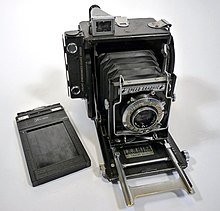Graflex
The Graflex was a large format - photo camera , which in its first version in 1901 by the Folmer & Schwing Manufacturing Company of New York was built with a wooden enclosure. Photographers valued them because of their resilience, their fast shutter speeds and, in the later versions, because of their wide range of uses, as they could use both sheet film and 36 mm roll film .
history
Kodak bought Folmer & Schwing as early as 1905 . From this point on, a limited edition of the elaborate cameras was produced there. In 1926 the company became independent again from Kodak and was now called Folmer Graflex Corporation . In the second half of the 1920s, the manufacturer was considered the " non plus ultra " for large format cameras .
However , by the 1940s at the latest , the compact cameras became serious competition for the small series manufacturer in the professional sector. Despite their size, they even took war photographers like Damien Parer and George Silk with them to their locations in Egypt and New Guinea , where they soon began to appreciate the advantages of the more flexible Contax .
In 1948, the Super D Graflex was built, the last modification, the production of which was discontinued ten years later. The standard lens on this camera was a Kodak Anastigmat F4.5, which could be replaced. In this version, the aforementioned roll film, individual negative strips, sheet film , modern “packs” or the old glass plates could be used. 25 different exposure times were possible, with the fastest shutter speed being 1/1000 of a second. The sharpness of the images is still appreciated by collectors today.
The company developed or adopted a number of other camera models before filing for bankruptcy in 1973.
The last new development was the XL, which was intended as a press camera and was very similar in concept to the Mamiya Universal . There were three models, with and without a rangefinder and as a wide-angle variant. Eight lenses from Carl Zeiss and Schneider were offered.
After the bankruptcy, the Japanese manufacturer Toyo (now Toyo View ) bought the tools from Graflex Speed and offered them under the name Graphic Speed from 1979 to 1985.
Trivia
- The director Stanley Kubrick began his career as a teenager with a Graflex, a gift from his father.
- In 1977 the Graflex 3-cell flash became particularly famous. It fell, converted into a lightsaber , into the hands of Luke Skywalker in the film Star Wars A New Hope by George Lucas. There the lightsaber developed into an icon for the Star Wars series. In the sequel The Empire Strikes Back , Luke lost the lightsaber. This reappeared in 2015 in the now 7th episode The Awakening of Power . This time it fell into Rey's hands.
See also
Web links
- Graphic / Graflex FAQ. LargeFormatPhotography.info
- Graflex.org - info page
- Enter the world of Graflex. Private collection by Jo Lommen
Individual evidence
- ^ Biography of Stanley Kubrick ( memento from July 19, 2009 in the Internet Archive ) on stanleykubrick.de.

